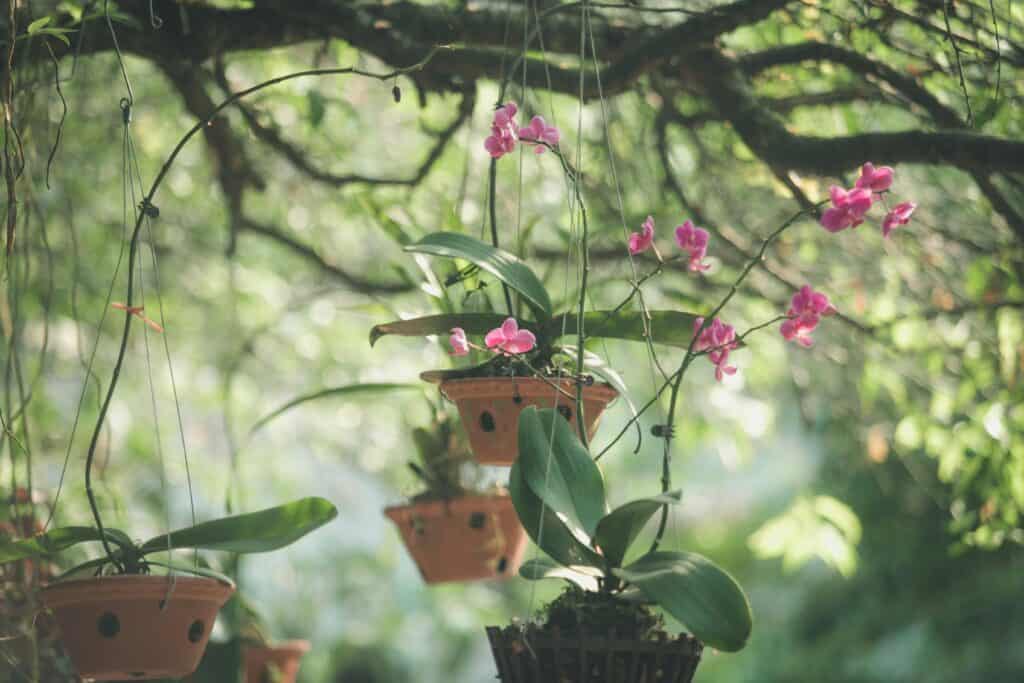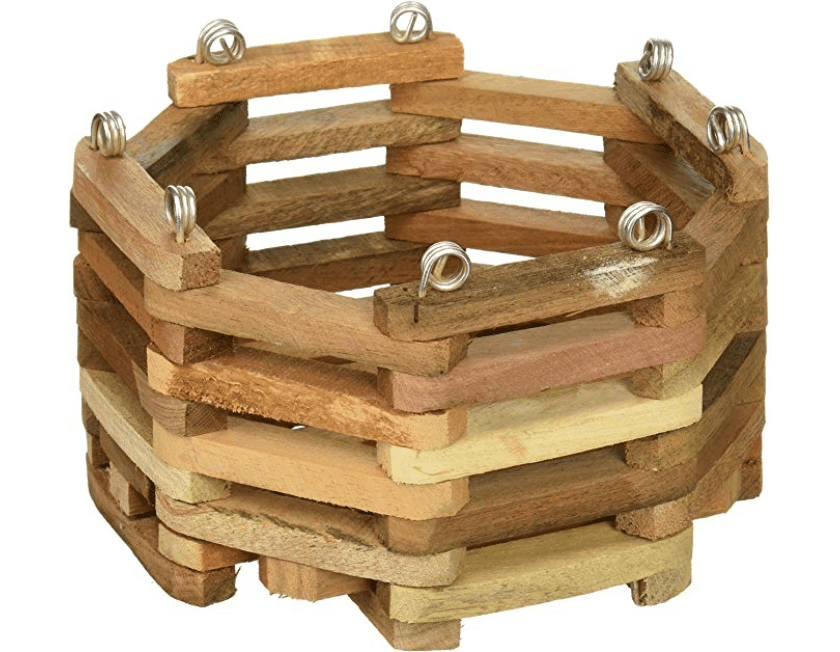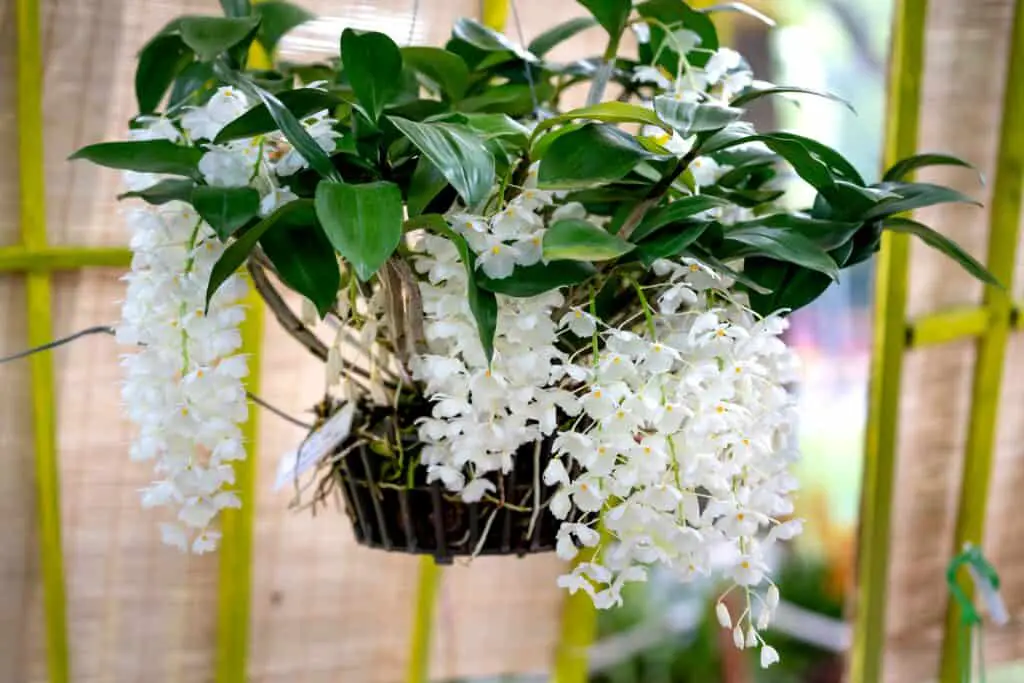Hanging baskets are a popular choice for gardeners who want to add a touch of beauty and greenery to their outdoor spaces. Unlike potted plants, hanging baskets are suspended from hooks or brackets, allowing them to hang freely in the air. This unique feature not only adds visual interest but also provides a practical solution for those with limited space.
What are Hanging Baskets in Orchid Care
Yet in orchid care, hanging baskets are something different altogether. The hanging baskets that are most used are a square structure made typically from wood with wide open spaces for abundant airflow. Recently, hanging baskets made from wire are now increasingly popular too.
The lesser seen hanging baskets are those made from coconut fiber and lined with plastic, normally associated with other hanging flower baskets, although they can also be used but with extra precautions for overwatering.
Another option for hanging baskets would be terracotta pots with holes in them that are suspended. Since their care and mounting is the same as any traditional pot, I will leave them out of this tutorial, focusing mainly on the wood baskets and coconut fiber liners.
My personal preference is the wood slated baskets, and they are what I will be referring to in this article.

Differences in Hanging Baskets and Potted Plants
One of the key differences between hanging baskets and potted plants is the way they are watered. While potted plants typically require watering from the top, hanging baskets need to be watered from the bottom. This is because the media in hanging baskets tends to dry out more quickly due to increased exposure to air and sunlight.
By watering from the bottom, you ensure that the roots receive an adequate amount of moisture without overwatering the foliage. If you are using a typical orchid basket, then watering can also be done from sides and from the top.
When it comes to orchids in hanging baskets, it’s important to strike the right balance with watering. Orchids are known for their sensitivity to overwatering, so it’s crucial to avoid waterlogged conditions. Instead, orchids in hanging baskets should be watered when the potting media feels slightly dry to the touch. This allows the roots to receive moisture without becoming saturated, promoting healthy growth and preventing root rot.
By understanding the unique characteristics of hanging baskets and the specific watering needs of orchids, you can create a thriving and visually stunning display in your outdoor space. So, whether you’re a seasoned gardener or just starting out, consider adding hanging baskets with orchids to your collection for a touch of elegance and beauty.
Orchids That Grow Well in Hanging Baskets
When it comes to choosing orchids for hanging baskets, there are several varieties that are well-suited for this type of display. One popular choice is the Phalaenopsis orchid, also known as the moth orchid. This is the one you will most commonly see in supermarkets and grocery stores. Phalaenopsis orchids have long flower stems that gracefully hang down, making them a perfect fit for hanging baskets. These orchids come in a wide range of colors, from pure white to vibrant pinks and purples, allowing you to create a stunning display.
Even though the Phalaenopsis is the most popular choice, the Vanda orchid, known for its vibrant colors and long-lasting blooms, is the number one orchid for orchid baskets. They naturally have more thick roots that hang down than the normal Phalaenopsis orchid. In fact, Vandas have a hard time growing in the normal orchid pots that any other orchid would grow in due to their long roots. If you are going with the coconut fiber half-circle basket, then I would advise against the vanda. Its roots need a place to dangle.
Another orchid that thrives in hanging baskets is the Pendulous Cymbidium. These orchids produce clusters of flowers that cascade down from the stems, creating a beautiful waterfall effect. Cymbidiums come in various colors, including white, yellow, and purple, adding a touch of elegance to any hanging basket.
If you’re looking for a more unique option, consider the Oncidium orchid, also known as the dancing lady orchid. These orchids have delicate, cascading flower spikes that resemble dancing figures. With their vibrant colors and intricate patterns, Oncidium orchids are sure to be a focal point in any hanging basket.
If you aren’t looking for a long orchid stem that hangs down, but rather an upright orchid for your hanging display, Cattleyas and Dendrobiums are good picks.
By choosing orchids with long flower stems that hang down, like Phalaenopsis, Dendrobium, Oncidium, Cattleya, and Vanda orchids, you can create a stunning hanging basket display that will bring beauty and elegance to any space.

Wood Basket for Hanging Orchids (Click here to check out some prices on Amazon)
Can I Place Other Flowers in the Hanging Basket with the Orchid?
Orchids are unique and fascinating plants that stand out from other plant species. One of the reasons why orchids are different is their classification as epiphytes. An epiphyte is a plant that grows on another plant, such as a tree, without deriving nutrients from it. Most orchids don’t grow in soil. Instead, orchids use their specialized roots to anchor themselves to the host plant and absorb moisture and nutrients from the air and rainwater.
Unlike most plants that have roots buried in soil, orchids have aerial roots that are adapted to their epiphytic lifestyle. These roots are covered in a spongy tissue called velamen, which helps them absorb moisture and nutrients from the surrounding environment. This unique adaptation allows orchids to thrive in diverse habitats, including tropical rainforests and even deserts.
In addition to their aesthetic appeal, orchids also have a reputation for being challenging to grow. While they may require specific care and conditions, with a little knowledge and attention, anyone can successfully cultivate these stunning plants even in hanging baskets. The key is to use plants that also share the same potting media as orchids or use a divider to separate the orchids from other plants inside the hanging basket.
This means that it’s tricky to plant other types of plants together with the orchid. If oyu can find a way to create different potting media in the same basket, then it works.

Orchid Potting Media (for Baskets)
When it comes to potting orchids in hanging baskets, choosing the right potting media is crucial for their growth and overall health. Orchids have unique needs, and using the appropriate potting media can provide the ideal conditions for their roots to thrive.
I’ve written an entire article about orchid potting media that you can read here (LINK ), but I will summarize it quickly if you don’t want to read it all.
), but I will summarize it quickly if you don’t want to read it all.
There are several items that can be added to orchid potting media to create a suitable growing environment. One common component is sphagnum moss, which has excellent water retention properties. This type of moss can hold moisture while still allowing for proper drainage, preventing the roots from becoming waterlogged. Sphagnum moss also provides a stable environment for the roots, promoting healthy growth.
Since hanging baskets dry out quicker than closed vases or pots, you will need to add more sphagnum moss to your hanging basket.
Another ingredient that can be included in orchid potting media is bark. Bark provides good aeration and drainage, allowing air to circulate around the roots. This helps prevent root rot and allows the roots to breathe properly. Orchids with aerial roots, such as Phalaenopsis, benefit from the use of bark in their potting mix.
Other materials that can be added to orchid potting media include perlite, charcoal, and coconut husk chips. These components help improve drainage, provide aeration, and retain moisture, creating a balanced environment for orchid roots.
When potting orchids, it’s important to choose a potting media that suits the specific needs of the orchid species. Just remember that orchids in hanging baskets will prefer a more moisture-retentive mix, rather than a well-draining medium. Understanding the water requirements of your orchid will help you select the appropriate potting media.
Depending on your climate, if it is extremly humid, you may not need any potting media at all.
Difference of an Orchid Mount and a Hanging Basket
Mounting an orchid on wood is a popular alternative to using a hanging basket. This method allows orchids to grow in a more natural and aesthetically pleasing way. One of the main advantages of mounting an orchid on wood is that it mimics the orchid’s natural habitat, where they often grow on trees or rocks.
When it comes to choosing the right type of wood for mounting an orchid, there are a few options to consider. One common choice is cork bark, which is lightweight and provides a rough surface for the orchid’s roots to attach to.
Another option is tree fern fiber, which is a fibrous material that retains moisture well and provides a stable base for the orchid. Other types of wood that can be used include driftwood and grapevine, which add a unique and rustic look to the display.
I’ve written a whole article that is more in depth than the summary I’m including here, so please read that if you are interested (LINK).
While mounting an orchid on wood offers a natural and visually appealing way to grow orchids, it does require some additional care. Orchids mounted on wood need to be watered more frequently than those in hanging baskets, as the wood tends to dry out faster. It’s important to mist the orchid and the wood regularly to maintain the right level of humidity. Additionally, mounted orchids may require more frequent fertilization to ensure they receive the necessary nutrients.
In conclusion, mounting an orchid on wood provides a unique and natural way to display these beautiful plants. With the right type of wood and proper care, orchids can thrive in this alternative growing method. Whether you choose a hanging basket or a mounted orchid, both options offer their own advantages and can be a stunning addition to any indoor or outdoor space.
How to Care for your Hanging Basket Orchid
To care for your hanging basket orchid, it’s important to understand its specific needs in terms of watering, sunlight, fertilizer, repotting, and temperatures.
When it comes to watering your hanging basket orchid, it’s crucial to strike a balance. Overwatering can lead to root rot, while underwatering can cause the plant to dry out. The best approach is to water the orchid thoroughly, allowing the excess water to drain out completely. Then, wait until the top inch of the potting media feels dry before watering again.
In terms of sunlight, hanging basket orchids thrive in bright, indirect light. They should be placed near a window where they can receive filtered sunlight throughout the day. Avoid exposing them to direct sunlight, as it can scorch their delicate leaves.
Fertilizing your hanging basket orchid is essential for its overall health and blooming. Use a balanced orchid fertilizer and follow the instructions on the package. Generally, it’s recommended to fertilize the orchid every two weeks during the growing season and reduce the frequency during the dormant period.
Repotting is necessary when the orchid outgrows its current hanging basket (which probably won’t happen anytime soon) or when the potting media breaks down. It’s best to repot the orchid during its active leaf growth phase, typically in spring or early summer, but not when it is in bloom. Use a well-draining orchid potting mix and gently remove the orchid from its current pot, trimming any dead or damaged roots before placing it in the new pot.
Lastly, hanging basket orchids prefer temperatures between 60°F and 80°F (15°C to 27°C). Avoid exposing them to extreme temperature fluctuations or drafts, as it can stress the plant.
By following these care guidelines, you can ensure that your hanging basket orchid thrives and rewards you with beautiful blooms. Remember to monitor its condition regularly and make adjustments as needed to provide the best care possible.
Don’t Stop Learning!
If you want to be included in more information and get a 14-page fertilization guide, please sign up for my newsletter. I don’t spam, but send emails out bi-monthly with some curious topics of interest. If you want more information, click here to go to a specific page on this website where I explain it more in detail.

Also, if you are looking for an orchid journal to keep your notes specifically about orchid care, check out my 2 solutions for that on this page. If note-keeping isn’t your thing, then there is a free excel spreadsheet that you can download. Click here for more information on how to do that.
If you subscribe to my newsletter, I will send you a 14-page guide on the main tips of orchid fertilizer. It is downloadable and you can print it out on your computer. I designed the guide to double up as a coloring book, just to make it fun.
Signs your Hanging Basket Orchid is not Well
Keeping a close eye on the health of your hanging basket orchid is crucial to ensure its longevity and beauty. Here are some signs to watch out for that indicate your orchid may not be in optimal health.
One common sign of a problem is the presence of black spots on the leaves. These spots can be an indication of a fungal or bacterial infection, which can quickly spread and harm the plant if left untreated. If you notice black spots, it’s important to take action promptly to prevent further damage.
Another sign to look out for is wrinkled leaves. Wrinkled leaves are often a sign of dehydration, indicating that your orchid is not receiving enough water. This can be caused by underwatering or improper watering techniques. To remedy this, make sure to water your orchid thoroughly and consistently, allowing the potting media to dry out slightly between waterings.
Discoloration in the leaves is another red flag. If you notice yellowing, browning, or spotting on the leaves, it could be a sign of nutrient deficiencies, pest infestation, or disease. It’s important to identify the underlying cause and take appropriate measures to address it.
Lastly, if you notice water exiting the pot with a foul smell, it could indicate root rot. Root rot occurs when the roots are consistently exposed to excess moisture, leading to decay and a foul odor. To prevent root rot, ensure proper drainage and avoid overwatering your orchid.
By being vigilant and addressing these signs promptly, you can ensure the health and vitality of your hanging basket orchid, allowing it to thrive and bring beauty to your space.
Other Plants in Hanging Baskets
When it comes to choosing plants for hanging baskets, there are several options that can thrive in this unique environment. One popular choice is the “Spider Plant,” known for its long, arching leaves that cascade beautifully from the basket. This plant is not only visually appealing but also easy to care for, making it a great option for beginners.
Another plant that goes well in hanging baskets is the “Pothos.” With its trailing vines and heart-shaped leaves, the Pothos adds a touch of elegance to any space. It is also known for its air-purifying properties, making it a healthy choice for indoor environments.
If you’re looking for a flowering plant, consider the “Begonia.” With its vibrant blooms in various colors, the Begonia adds a pop of color to your hanging baskets. It thrives in partial shade and requires regular watering to keep the soil moist.
For a more tropical feel, the “Fern” is an excellent choice. With its delicate fronds and lush green foliage, the Fern brings a touch of nature to your hanging baskets. It prefers indirect light and high humidity, so be sure to mist it regularly.
Lastly, the “Lipstick Plant” is a unique option for hanging baskets. Its dark green leaves and vibrant red flowers resemble a tube of lipstick, hence the name. This plant prefers bright, indirect light and moderate watering.
By choosing plants like the Spider Plant, Pothos, Begonia, Fern, and Lipstick Plant, you can create a stunning display in your hanging baskets. Remember to consider the lighting and watering needs of each plant to ensure their health and vitality.
More Info on Orchids in Hanging Baskets
I’ve put together a step-by-step guide of how to mount the hanging basket for your orchid. You can read more on how to do that here (LINK ).
).
I hope this guide helped and if you have any questions, please leave them in the comment section. Thank you and Happy Cultivating!


Thanks for your instructive article
. I have an orchid that has black spots on leave, please could you give me a recommendation?
Thanks 😊
Hi Sara,
There is this article that I wrote that I hope helps. https://orchideria.com/no-leaf-orchid/ If that doesn’t solve the problem, you can look at the sphag-and-bag method, but it’s risky.